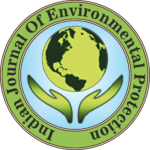IJEP 41(8): 860-864 : Vol. 41 Issue. 8 (August 2021)
Vinod Kumar*
C. R. Kisan College, Department of Geography, Jind, Haryana, India
Abstract
Environmental managers are interested to know landuse/land cover types and their change detection in time series for sustainable land management. Remote sensing (RS) and geographic information system (GIS) are now providing new tools for advanced ecosystem management. This paper describes the use of remote sensing and GIS in mapping landuse/land cover (LU/LC) in the Gagas river basin between 2000 and 2015, to detect the changes that have taken place in this status between these periods. Subsequently, an attempt was made at projecting the observed landuse/land cover in the next 15 years. In achieving this, land utilization rate and land absorption coefficient were generated to aid in the quantitative assessment of the change. The result of the work shows rapid growth in built-up land between 2000 and 2015. LANDSAT satellite data of the Gagas river basin area is used to detect LU/LC changes between 2000 and 2015 during the period of 15 years the change in land resources utilization and absorption is detected. LU/LC changes occur due to either natural or anthropogenic reasons.
Keywords
NDVI, Inventory, Change detection
References
- Kumar, P., et al. 2016. Estimation of accumulated soil organic carbon stock in tropical forest using geospatial strategy. Egypt J. Remote Sens. Space Sci., 19(1): 109-123.
- Kumar, P., et al. 2018. Assessing suitability of allometric models for predicting stem volume of Anogeissus pendula Edgew in Sariska Tiger Reserve, India. Remote Sens. Appl. Soc. Env., 10: 47-55.
- Kumar, P., et al. 2014. Efficient recognition of forest species biodiversity by inventory-based geospatial approach using LISS IV sensor. IEEE Sensors J., 15(3): 1884-1891.
- Rani, M., et al. 2019. NIR-red algorithms-based model for chlorophyll-a retrieval in highly turbid inland Densu river basin in south-east Ghana, West Africa. IET Image Process., 13(8): 1328-1332.
- Murthy, C.S., et al. 2016. Meteorological drought analysis over India using analytical framework on CPC rainfall time series. Natural Hazards. 81(1): 573-587.
- Wilkie, D.S. and J.T. Finn. 1996. Remote sensing imagery for natural resources monitoring. Columbia University Press, New York.
- FAO, UNEP. 1999. The future of our land: Facing the challenge. Guidelines for integrated planning for sustainable management of land resources. FAO, UNEP, Rome.
- Al-Tahir, R. and R. Mahabir. 2006. Geo-images in combating land degradation in the Caribbean. Opportunities and challenges. Proceedings of 3rd URISA Caribbean GIS Conference. Urban and Regional Information System Association (URISA), Bahamas.
- Balak, R. and A.S. Kolarkar. 1993. Remote sensing application in monitoring landuse changes in arid Rajasthan. Int. J. Remote Sensing. 14: 3191-3200.
- Chaurasia, R., et al. 1996. Landuse change analysis for agricultural management-A case study of Tehsil Talwandi Sabo, Punjab. J. Indian Society Remote Sensing. 24: 115-123.
- Kachhwala, T.S. 1985. Temporal monitoring of forest land for change detection and forest cover mapping through satellite remote sensing. 6th Asian Conference on Remote sensing, Hyderabad. Proceeding, pp 77-83.
- Star, J.L., J.E. Estes and K.C. McGwire. 1997. Integration of geographic information systems and remote sensing. In Geological magazine. Cambridge University Press, New York.
- Ruklanthi, S. 1996. Monitoring of landuse changes. Asian Conference on Remote Sensing (ACRS 1996), Asian Association on Remote Sensing.
- Grey, W.M.F., A.J. Luckman and D. Holland. 2007. Mapping urban change in the UK using satellite radar interferometry. J. Remote Sensing Env., 87: 16-22.
- Mariamni, H. 1997. Landuse-cover change detection using knowledge based approaches: Remote sensing and GIS. Asian Conference on Remote Sensing (ACRS 1997), Asian Association on Remote Sensing.
- Kumar, P., et al. 2018b. Prediction of spatial soil organic carbon distribution using Sentinel-2A and field inventory data in Sariska Tiger Reserve. Natural Hazards. 90(2): 693-704.
- Kamusoko, C. and M. Aniya. 2006. Landuse/cover change and landscape fragmentation analysis in the Bindura district, Zimbabwe. Land Degrad. Develop., 18(2):221-233.
- Anderson, et al. 1976. A landuse and land cover classification system for use with remote sensor data. Geological Survey Professional Paper No. 964. U.S. Government Printing Office, Washington, D.C.
- Verburg, P.H., et al. 2000. GIS based modeling of human-environment interactions for natural resource management: Applications in Asia. 4th International Conference on Integrating GIS and environmental modeling (GIS/EM4), Canada. Proceedings, pp 1-13.
- Singh, A. 1989. Digital change detection technique using remotely sensed data. Int. J. Remote Sensing. 10: 989-1003.
- Mouat, D.A. and G.M. Glenda. 1993. Remote sensing techniques in the analysis of change deletion. Geocarto. Int., 8(2): 39-50.
